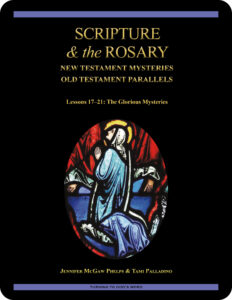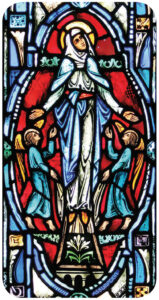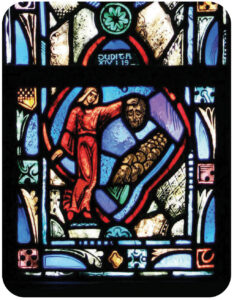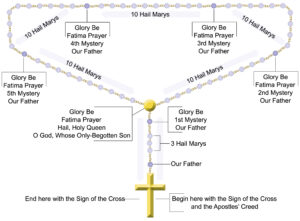 Scripture & the Rosary:
Scripture & the Rosary:
New Testament Mysteries,
Old Testament Parallels
The Fourth Glorious Mystery
Lesson 20 I Go to Prepare a Place for You
the Gospel According to John 14:1–11
the Book of Judith 13:15–20
Revised Standard Version Catholic Edition (RSVCE)*
New American Bible Revised Edition (NABRE)*
Catechism of the Catholic Church
Rosarium Virginis Mariae (Rosary of the Virgin Mary)
ex libris (in our library)
cross references for Scripture & the Rosary
next lesson: A Woman Clothed with the Sun
This material coordinates with Lesson 20 on pages 76–79 in Scripture & the Rosary: New Testament Mysteries, Old Testament Parallels.
And Mary said, “My soul magnifies the Lord, and my spirit rejoices in God my Savior,
for he has regarded the low estate of his handmaiden.
For behold, henceforth all generations will call me blessed;
for he who is mighty has done great things for me, and holy is his name.”
—the Gospel According to Luke 1:46–49
welcome to our in-depth study of Scripture & the Rosary
We invite groups and individuals to become acquainted with Turning to God’s Word Catholic Bible  studies through
studies through  Scripture & the Rosary: New Testament Mysteries, Old Testament Parallels, which has been granted an imprimatur. Although no longer available in print, the first six lessons can be downloaded from our website. The remaining 20 lessons are posted throughout the liturgical year along with their related online study pages. Click here to access Lesson 17 through Lesson 21. If you have a Bible-study question or comment, you can contact our authors any time by using one of the “ask us your question” or “what do you think” buttons on any online study page.
Scripture & the Rosary: New Testament Mysteries, Old Testament Parallels, which has been granted an imprimatur. Although no longer available in print, the first six lessons can be downloaded from our website. The remaining 20 lessons are posted throughout the liturgical year along with their related online study pages. Click here to access Lesson 17 through Lesson 21. If you have a Bible-study question or comment, you can contact our authors any time by using one of the “ask us your question” or “what do you think” buttons on any online study page.
open with prayer
It’s always wise to begin any Bible study with prayer, whether reading the Scriptures alone or meeting with others in a discussion group. You can pray using your own words or use one of the opening prayers on our website. We especially like the following:
Lord Jesus, you promised to send your Holy Spirit to teach us all things.
As we read and study your word today,
allow it to touch our hearts and change our lives. Amen.
making connections—two women honored for faith & perseverance
 Lesson 20 in Scripture & the Rosary: New Testament Mysteries, Old Testament Parallels looks at the Fourth Glorious Mystery, the Assumption of the Blessed Virgin Mary. The New Testament text is from the Gospel According to John 14:1–11, and the Old Testament parallel is from the Book of Judith 13:15–20. You can learn more about Jesus teaching about Resurrection in Lesson 14 I Am the Resurrection & the Life in the Turning
Lesson 20 in Scripture & the Rosary: New Testament Mysteries, Old Testament Parallels looks at the Fourth Glorious Mystery, the Assumption of the Blessed Virgin Mary. The New Testament text is from the Gospel According to John 14:1–11, and the Old Testament parallel is from the Book of Judith 13:15–20. You can learn more about Jesus teaching about Resurrection in Lesson 14 I Am the Resurrection & the Life in the Turning  to God’s Word Catholic Bible study The Gospel According to John: An Encounter with Grace & Truth.
to God’s Word Catholic Bible study The Gospel According to John: An Encounter with Grace & Truth.
 ? What qualities does the Blessed Virgin Mary share with the Old Testament heroine Judith?
? What qualities does the Blessed Virgin Mary share with the Old Testament heroine Judith?
? What did Judith do to win honor among her people?
? What evidence in the words of blessing uttered about Judith by Uzziah can you find to indicate Judith’s blessing is eternal in nature?
? In the passage from the Gospel According to John, what does Jesus indicate is required of his followers if they wish to find a permanent and eternal place with Jesus?
? Consider what ramifications the Assumption of the Blessed Virgin Mary might have for serious Christians?
? Look at the pictures of the stained glass window panels on pages 76 and 78 in Scripture & the Rosary: New Testament Mysteries, Old Testament Parallels. What similarities do you see between the depictions of these New and Old Testament scenes?
supplemental Scripture
The key to understanding Lesson 20, Mary’s Assumption into Heaven, is to focus on the way in which the Blessed Virgin calls attention to her Son. The New  Testament text is taken from the Gospel According to John 14:1–11. The Old Testament parallel is the gruesome account of the Israelites’ defeat of Holofernes and the Assyrians, which came about through the actions of a woman. It can be found in the Book of Judith 13:15–20. A close look at the role of the Blessed Virgin Mary throughout the Gospels will aid in understanding Lesson 20, but it’s helpful to note the way that Mary is described in the Gospel According to John. Familiarity with the entire Old Testament Book of Judith, which is deuterocanonical, also is recommended.
Testament text is taken from the Gospel According to John 14:1–11. The Old Testament parallel is the gruesome account of the Israelites’ defeat of Holofernes and the Assyrians, which came about through the actions of a woman. It can be found in the Book of Judith 13:15–20. A close look at the role of the Blessed Virgin Mary throughout the Gospels will aid in understanding Lesson 20, but it’s helpful to note the way that Mary is described in the Gospel According to John. Familiarity with the entire Old Testament Book of Judith, which is deuterocanonical, also is recommended.
 read the Catechism—about Mary’s Assumption
read the Catechism—about Mary’s Assumption
Celebrated on August 15, the Blessed Virgin Mary’s Assumption is seen by the Church as a sign of the resurrection awaiting all Christians. Paragraph 966 in the Catechism of the Catholic Church teaches that Mary’s Assumption “is a singular participation in her Son’s Resurrection and an anticipation of the resurrection of other Christians.”
? How would you explain this teaching to someone interested in learning more about Catholicism?
? Why do you think it is that Catholic teaching about the Blessed Virgin Mary is so difficult  for many non-Catholics to understand?
for many non-Catholics to understand?
? When are you most likely to turn to Mary for intercession?
? What effect has your study of the Rosary had on your relationship with the Blessed Virgin Mary?
 Assumption—you could look it up in our archives
Assumption—you could look it up in our archives
The mysteries of the Assumption of the Blessed Virgin Mary and the Ascension of Jesus differ theologically. To learn how these words significantly differ in meaning, read Lost in Translation, an online column in which Turning to God’s Word author Matthew Phelps helps readers connect with ideas expressed in the original languages of the Scriptures. New Lost in Translation entries are posted on Mondays, and past entries are archived on our website. Contact us if you’d like to receive Lost in Translation by email every week.
do you know the spiritual fruit associated with the Fourth Glorious Mystery?
Hint: It’s considered essential when facing the difficulties life offers. You can find out what it is in the “Fruits of Prayer” box on page 77 in Scripture & the Rosary: New Testament Mysteries, Old Testament Parallels. In what ways might this fruit benefit you in your everyday life?
 the best Catholic commentary about Scripture
the best Catholic commentary about Scripture
To find out more about how Church teaching is supported by passages in Scripture & the Rosary: New Testament Mysteries, Old Testament Parallels, check out the Index of Citations in the Catechism of the Catholic Church. Links (Revised Standard Version Catholic Edition [RSVCE*]) to the primary Scripture passages in the lesson and relevant paragraphs in the Catechism are provided here. Not every passage in the biblical text for this study is referenced in a Catechism paragraph, however, including the passage in this lesson from the Book of Judith 13:15–20.
the Gospel According to John 14:1—paragraph 151
the Gospel According to John 14:2—paragraph 661
the Gospel According to John 14:2–3—paragraph 2795
the Gospel According to John 14:3—paragraph 1025
the Gospel According to John 14:6—paragraphs 74, 459, 1698, 2466, 2614
the Gospel According to John 14:9—paragraph 516
the Gospel According to John 14:9–10—paragraph 470
to learn more, read more Scripture
When you’re having difficulty understanding a passage of Scripture, it can help to read the  cross references—but looking these up takes time. We’ve compiled the cross references from the Revised Standard Version Second Catholic Edition (RSV2CE)—the same translation that we reprint in our study books. The list can be found at the top of every online study page, and it includes links to cross references in the primary biblical texts for all of the lessons in Scripture and the Rosary; New Testament Mysteries, Old Testament Parallels.
cross references—but looking these up takes time. We’ve compiled the cross references from the Revised Standard Version Second Catholic Edition (RSV2CE)—the same translation that we reprint in our study books. The list can be found at the top of every online study page, and it includes links to cross references in the primary biblical texts for all of the lessons in Scripture and the Rosary; New Testament Mysteries, Old Testament Parallels.
don’t forget about our indexes & extra online material

 If you’re trying to locate information about a Scripture passage, you can look it up in the index at the back of the online version of this study. If you want to revisit a commentary, you can look it up by title in the topics index. If you want to learn more about another book of the Bible for which there’s a Turning to God’s Word study, you can read online commentaries and watch any accompanying videos by choosing a lesson from one of the study directories. (There are no lesson videos with Scripture & the Rosary: New Testament Mysteries, Old Testament Parallels.) Finally, if you have a question or would like to make a comment about any of our studies, you can use the “ask us your question” or “what do you think” button to email our authors.
If you’re trying to locate information about a Scripture passage, you can look it up in the index at the back of the online version of this study. If you want to revisit a commentary, you can look it up by title in the topics index. If you want to learn more about another book of the Bible for which there’s a Turning to God’s Word study, you can read online commentaries and watch any accompanying videos by choosing a lesson from one of the study directories. (There are no lesson videos with Scripture & the Rosary: New Testament Mysteries, Old Testament Parallels.) Finally, if you have a question or would like to make a comment about any of our studies, you can use the “ask us your question” or “what do you think” button to email our authors.
ex libris—Church documents & books about religious topics
Link to magisterial documents referred to in our Bible studies at ex libris—magisterial documents.  This listing includes significant recent encyclicals as well as a number of historical Church documents. Recommended books related to Scripture study can be found at ex libris—main bookshelf.
This listing includes significant recent encyclicals as well as a number of historical Church documents. Recommended books related to Scripture study can be found at ex libris—main bookshelf.
wondering how to pronounce some of these words?
The following links are to readings from the New International Version (NIV) Bible. To listen, click on the audio icon above the printed text. Although not taken from the translations used in our study materials, the NIV readings provide an audio guide to pronunciation of words in this lesson’s primary biblical texts. The New International Version (NIV) translation doesn’t include the deuterocanonical Book of Judith. A close online version of the translation of the Bible used in Catholic liturgy in the United States as well as an audio guide for daily Mass readings for the current month can be found on the website of the United States Conference of Catholic Bishops (USCCB).
the Gospel According to John 14:1–11 (NIV)
close by praying the Fourth Glorious Mystery
 Many of our study groups like to conclude discussions of Scripture & the Rosary: New Testament Mysteries, Old Testament Parallels by praying a decade of the Rosary devoted to the Mystery that’s the focus of their lesson. A number of Catholics include a request for an increase in the spiritual fruit associated with the mystery. You can find out what’s associated with the Fourth Glorious Mystery in the “Fruits of Prayer” box on page 77 in Scripture & the Rosary: New Testament Mysteries, Old Testament Parallels.
Many of our study groups like to conclude discussions of Scripture & the Rosary: New Testament Mysteries, Old Testament Parallels by praying a decade of the Rosary devoted to the Mystery that’s the focus of their lesson. A number of Catholics include a request for an increase in the spiritual fruit associated with the mystery. You can find out what’s associated with the Fourth Glorious Mystery in the “Fruits of Prayer” box on page 77 in Scripture & the Rosary: New Testament Mysteries, Old Testament Parallels.
 We invite you to pray along with Turning to God’s Word co-founder Tami Palladino and her daughter Anne Marie on their prayer video featuring the Fourth Glorious Mystery of the Rosary. The prayers and videos for all 20 mysteries are accessible year-round at how to pray the Rosary, and you can access a link to Tami and Anne Marie’s how-to video to learn what’s important about praying the Rosary. Clicking on the diagram (above) will take you to the website page with the Rosary prayers.
We invite you to pray along with Turning to God’s Word co-founder Tami Palladino and her daughter Anne Marie on their prayer video featuring the Fourth Glorious Mystery of the Rosary. The prayers and videos for all 20 mysteries are accessible year-round at how to pray the Rosary, and you can access a link to Tami and Anne Marie’s how-to video to learn what’s important about praying the Rosary. Clicking on the diagram (above) will take you to the website page with the Rosary prayers.
Lesson 21 A Woman Clothed with the Sun (the Fifth Glorious Mystery, Mary Is Crowned Queen of Heaven)—the book of Revelation 11:19—12:6 and the Book of Esther 8:3–8
Lesson 19 A Sound Came from Heaven Like the Rush of a Mighty Wind (the Third Glorious Mystery, the Descent of the Holy Spirit)—the Acts of the Apostles 2:1–4, the Acts of the Apostles 2:14–18, and the Book of Isaiah 6:1–9
you also may like our study of the Gospel According to John
 The Gospel According to John: An Encounter with Grace & Truth, a 25-lesson Catholic Bible study with an imprimatur, examines the Fourth Gospel’s view of Jesus Christ as the Son of God, with special emphasis on the institution of the sacraments of the Church as the means by which Christians are purified and made holy. This recently revised study includes maps and additional commentary, and takes a closer look at the way in which Jesus relates to individual men and women. Click on the book’s cover to view a sample lesson.
The Gospel According to John: An Encounter with Grace & Truth, a 25-lesson Catholic Bible study with an imprimatur, examines the Fourth Gospel’s view of Jesus Christ as the Son of God, with special emphasis on the institution of the sacraments of the Church as the means by which Christians are purified and made holy. This recently revised study includes maps and additional commentary, and takes a closer look at the way in which Jesus relates to individual men and women. Click on the book’s cover to view a sample lesson.
start a Turning to God’s Word Bible study
 Thank you for your interest in Scripture & the Rosary: New Testament Mysteries, Old Testament Parallels.
Thank you for your interest in Scripture & the Rosary: New Testament Mysteries, Old Testament Parallels.  Information about beginning a Turning to God’s Word Bible study can be found at start a Bible study. Tami, Matthew, and I are available to answer your questions and to offer support. You may use this email to contact us directly if you’re interested in starting a Turning to God study or in having your study schedule listed with other TtGW study groups on our website. —Jennifer
Information about beginning a Turning to God’s Word Bible study can be found at start a Bible study. Tami, Matthew, and I are available to answer your questions and to offer support. You may use this email to contact us directly if you’re interested in starting a Turning to God study or in having your study schedule listed with other TtGW study groups on our website. —Jennifer
*There are seven deuterocanonical books in the Old Testament—the Books of Tobit, Judith, Wisdom, Sirach, Baruch, and First and Second Maccabees, as well as some passages in the Books of Esther and Daniel. Protestants usually refer to these works as “apocryphal,” a word that means “outside the (Protestant) canon” because they’re excluded from most Protestant Bibles. The word “deuterocanonical” means “second canon”; Catholics use that word to refer to any section of the Catholic Old Testament for which there are no extant, or existing, Hebrew manuscripts. All of the deuterocanonical books appear in the Septuagint, the earliest remaining versions of which date to the 1st century B.C. This Greek translation of the Old Testament was in common use by Jews at the time of Jesus—but the same books aren’t found in existing Hebrew manuscripts, which aren’t as old as the oldest version of the Septuagint. Learn more by reading How Do Catholic & Protestant Bibles Differ?
Turning to God’s Word printed Bible studies use the 2006 Revised Standard Version Second Catholic Edition (RSV2CE) translation for all Scripture references except those to the Psalms, which are taken from The Abbey Psalms and Canticles, prepared by the Benedictine monks of Conception Abbey and published in 2020 by the United States Conference of Catholic Bishops (USCCB). All Scripture links for the digital version of Scripture & the Rosary: New Testament Mysteries, Old Testament Parallels are to the 1966 Revised Standard Version Catholic Edition (RSVCE) translation. The New International Version (NIV) audio recordings follow the same chapter and verse numbering as the RSV Catholic translations, but the NIV translation doesn’t include the deuterocanonical books and passages.
The 1966 RSVCE uses archaic pronouns and verb forms such as “thee,” “thou,” “didst” in the Psalms and in direct quotations attributed to God. The 2006 RSV2CE replaces those with more accessible English. The few significant translation changes in the RSV2CE include rendering almah as “virgin” in the Book of Isaiah 7:14 and restoring the term “begotten” in the Gospel According to John 3:16.
Numbering varies for some passages in this Bible study. Turning to God’s Word studies follow the numbering in the Revised Standard Version Catholic translations (RSV2CE and RSVCE). Discrepancies in the New American Bible Revised Edition (NABRE) are noted in the Index of Scripture Citations.
 You can learn more about the Psalms by viewing a sample lesson from the Turning to God’s Word Catholic Bible study Sing a New Psalm: Communicating with God Through the Prayers of the Church—Volume I: Lauds & Vespers. The second part of that study, Sing a New Psalm: Communicating with God Through the Prayers of the Church—Volume II: Vigils, Day Prayer & Compline, is scheduled for publication in 2025. Some verse numbers may vary in different translations of the Psalms.
You can learn more about the Psalms by viewing a sample lesson from the Turning to God’s Word Catholic Bible study Sing a New Psalm: Communicating with God Through the Prayers of the Church—Volume I: Lauds & Vespers. The second part of that study, Sing a New Psalm: Communicating with God Through the Prayers of the Church—Volume II: Vigils, Day Prayer & Compline, is scheduled for publication in 2025. Some verse numbers may vary in different translations of the Psalms.
